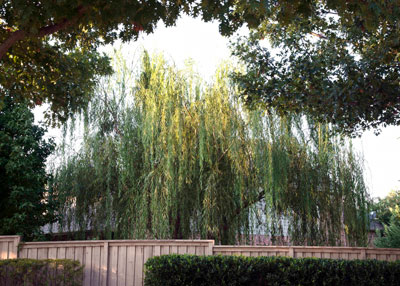Weeping willow isn’t for everyone
I happen to love this tree. But I’d never plant one in my landscape, nor can I ever picture myself recommending one for a typical urban landscape. I’ll explain why later.

Reasons to love weeping willow…
• Its grace.
• Its beauty.
What more can I say?
Its name and where it originated…
• Its scientific name is Salix babylonica. It’s a cousin to poplars and cottonwoods.
• The Missouri Botanical Garden lists its native home as China, going on to tell us that the species name “babylonica” was given to it by the father of binomial nomenclature Carl Linnaeus, but probably because he mistakenly thought it was the biblical willow of Babylon.
Instead, it most likely was carried along the Silk Road trade route from its native home in China, through Afghanistan, Iraq and Syria and into Europe in the early 1700s. The report from MOBOT says the trees growing along the Euphrates River in Babylon in biblical times were probably poplars instead. (It’s good to know that I wasn’t the only one who had trouble with a few plants in taxonomy. If Linnaeus did, too, I feel redeemed!)

How best to use weeping willow…
• Where you have ample room. Remember that its branches return to the ground.
• More as a backdrop than as a shade tree. It’s rather awkward to sit in the shade of a weeping willow.
• Near a stream bed or pond.
• Away from places where it might cause problems (see warnings below).
• Where your landscape won’t be ruined if it dies after a few years. Because it will.
Reasons not to like weeping willow…
• Short life expectancy (6-10 years).
• High water needs.
• Roots seek water, so will grow beneath slabs, drives, patios, walks to find moisture. They’ll invade cracks in septic systems and old sewer lines.
• Highly prone to insects and diseases (causes for those short life expectancies).
• Difficult to find in nurseries. (Nurserymen don’t want it on their consciences that they sell it.)
If you want to grow one…
• Root it from a cutting.
• I use cuttings that are pencil-sized and slightly smaller.
• I would put 8-10 of them into a pot filled with highly organic potting soil. Be careful to stick the stem part that was closest to the root system inserted down into the potting soil. I know that sounds logical, but when you take a cutting that’s been hanging upside-down, it’s easy to stick it upside-down in the rooting pot, and it will never form roots that way.
• Water the rooting soil thoroughly and put a piece of dry cleaner’s plastic loosely over it to hold in the moisture until the cuttings form roots. That should happen within a week or two.
• Pot up the rooted cuttings into gallon containers and care for them until late fall. One or two should be large enough to plant into your landscape at that point. Give the rest away.
